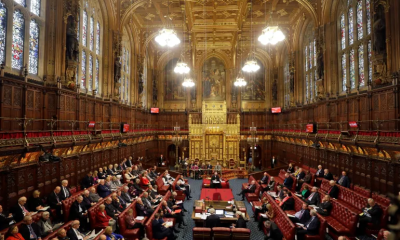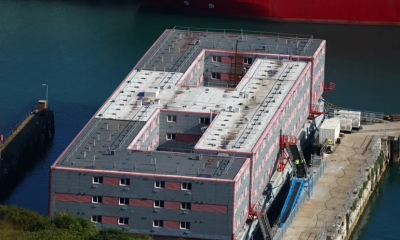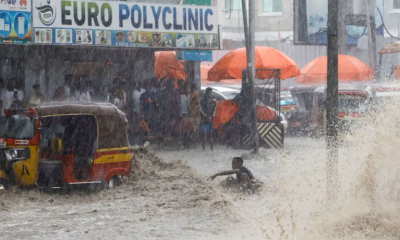Foreign News
Rishi Sunak sees off Tory rebellion in Rwanda bill vote

Prime Minister Rishi Sunak has seen off a Tory rebellion over his flagship Rwanda bill but still faces a battle to get it through Parliament.
The legislation comfortably passed its first Commons hurdle with a majority of 44, but there will be further votes in the new year. No Tory MPs voted against but some critics on the right of the party rebelled by abstaining.
Rebels said they had been told the PM would consider “tightening” the bill. But this could risk losing the support of more centrist Tory MPs, who have warned they would oppose any future changes which would breach international law.
The emergency legislation was drawn up to revive the government’s plan to send some asylum seekers to Rwanda. The government say the scheme is designed to deter migrants from crossing the Channel in small boats – something Mr Sunak has made one of his key priorities.
In a sign of nerves in Downing Street over the potential for a tight result, Climate Minister Graham Stuart flew back from the COP28 climate conference in Dubai to vote.
But despite some Tories on the right threatening to vote against the bill, in the end only opposition MPs did, and the bill passed by 313 votes to 269. Some 37 Tory MPs – including former Immigration Minister Robert Jenrick, who resigned over the legislation last week, and former Home Secretary Suella Braverman – did not record a vote.
The majority of these come from factions who earlier said they could not support the bill and are likely to have deliberately abstained. However, others may have been unable to attend to vote.
Shortly before the vote, five factions of backbench MPs – the European Research Group (ERG), the New Conservatives, the Common Sense Group, the Conservative Growth Group and Northern Research Group – announced they could not support the bill in its current form.
They plan to propose amendments and said they could vote the bill down when it returns to the Commons in the new year if the changes they wanted were not accepted.
ERG chairman Mark Francois, who was among those who abstained, told BBC News: “Our objection was that we don’t believe, as it’s currently drafted, the bill is firm enough to ensure that flights will take off to Rwanda. The prime minister had said that he would entertain tightening up the bill. We’re taking him at his word,” he said. “A number of MPs voted with the government tonight because they were told in private that there would be amendments later on.” However, agreeing to their demands would create new problems for the government.
The centrist One Nation group, which includes more than 100 Tory MPs, had recommended that its members vote for the bill, but warned it would oppose any future amendments “that would mean the UK government breaching the rule of law and its international obligations”.
Tougher legislation may also be more difficult to get through the House of Lords.
One Nation chairman Damian Green told BBC News the vote had seen far fewer abstentions than expected and that “if the government sticks to its guns then it can probably get this legislation through intact”.
Home Office Minister Chris Philp said the government would listen to ideas from MPs on how to improve the bill. “Like with any bill, government ministers will be talking to members of Parliament to see if there are ways of tightening this even further, to improve the drafting to make sure there are absolutely no loopholes at all,” he added.
The bill seeks to declare in UK law that Rwanda is a safe country to send asylum seekers to, after the Supreme Court ruled the policy was unlawful last month.
However, critics on the right of the party have argued it is not currently strong enough to prevent legal challenges to deportations.
A No 10 spokesperson said the bill was “the toughest legislation ever introduced to Parliament” and “makes clear that this Parliament, not any foreign court is sovereign”.
“We will now work to ensure that this bill gets on to the statute book so that we can get flights off to Rwanda and stop the boats,” the spokesperson added.
Labour voted against the bill, along with other opposition parties, and the party has said it would scrap the Rwanda plan if it wins the next election.
It says the millions of pounds given to Rwanda as part of the deal would be better spent tackling people-smuggling gangs.
Labour’s shadow home secretary Yvette Cooper said: “The Conservatives’ civil war is continuing, and the country is paying the price for this chaos.
“Today’s debate shows how weak Rishi Sunak is with this Tory psychodrama now dragging on into the new year.”
(BBC)
Foreign News
Nasa ‘Earthrise’ astronaut dies at 90 in plane crash

Apollo 8 astronaut Bill Anders, who snapped one of the most famous photographs taken in outer space, has died at the age of 90.
Officials say a small plane he was flying crashed into the water north of Seattle, Washington.
Anders’ son Greg confirmed that his father was flying the small plane, and that his body was recovered on Friday afternoon. “The family is devastated. He was a great pilot. He will be missed,” a statement from the family reads.
Anders – who was a lunar module pilot on the Apollo 8 mission – took the iconic Earthrise photograph, one of the most memorable and inspirational images of Earth from space.
Taken on Christmas Eve during the 1968 mission, the first crewed space flight to leave Earth and reach the Moon, the picture shows the planet rising above the horizon from the barren lunar surface.
Anders later described it as his most significant contribution to the space programme.

The image is widely credited with motivating the global environmental movement and leading to the creation of Earth Day, an annual event to promote activism and awareness of caring for the planet.
Speaking of the moment, Anders said: “We came all this way to explore the Moon, and the most important thing that we discovered was the Earth.”
Officials said on Friday that Anders crashed his plane around 11:40PDT (1940BST).
The US National Transportation Safety Board (NTSB) said the 90-year-old was flying a Beechcraft A A 45 – also known as a T-34. The agency said that the plane crashed about 80ft (25m) from the coast of Jones Island.
Anders also served as the backup pilot to the Apollo 11 mission, the name of the effort that led to the first Moon landing on July 24, 1969.
Following Anders’ retirement from the space programme in 1969, the former astronaut largely worked in the aerospace industry for several decades. He also served as US Ambassador to Norway for a year in the 1970s.
But he is best remembered for the Apollo 8 mission and the iconic photograph he took from space.
“In 1968, during Apollo 8, Bill Anders offered to humanity among the deepest of gifts an astronaut can give. He traveled to the threshold of the Moon and helped all of us see something else: ourselves,” Nasa Administrator Bill Nelson said in a statement.
Mark Kelly, a former astronaut who now serves as a US Senator for the state of Arizona, said in a post on X, formerly Twitter, that Anders “inspired me and generations of astronauts and explorers. My thoughts are with his family and friends”.
[BBC]
Foreign News
China’s Chang’e-6 lifts off from far side of Moon with rock samples

A Chinese spacecraft carrying rock and soil samples from the far side of the Moon has lifted off from the lunar surface to start its journey back to Earth, according to state media.
The achievement on Tuesday is a world first and the latest leap for Beijing’s decades-old space programme, which aims to send a crewed mission to the Moon by 2030.
The Xinhua News Agency, citing the China National Space Administration (CNSA), said that the ascender of the Chang’e-6 probe took off at 7:38am local time on Tuesday (23:38 GMT) and entered a preset orbit around the moon.
It described the move as “an unprecedented feat in human lunar exploration history”.
The Chang’e-6 probe was launched last month and its lander touched down on the far side of the Moon on Sunday. It used a drill and robotic arm to dig up soil on and below the Moon’s surface, according to Xinhua.
After successfully gathering its samples, the Chang’e-6 unfurled China’s national flag for the first time on the far side of the Moon, it said.
The agency cited the CNSA as saying that the spacecraft stowed the samples it had gathered in a container inside the ascender of the probe as planned.
[Aljazeera]
Foreign News
China says its spacecraft lands on Moon’s far side

China says its uncrewed craft has successfully landed on the far side of the Moon – an unexplored place almost no-one tries to go.
The Chang’e 6 touched down in the South Pole-Aitken Basin at 06:23 Beijing time on Sunday morning (22:23 GMT Saturday), the China National Space Administration (CNSA) said.
Launched on 3 May, the mission aims to collect precious rock and soil from this region for the first time in history. The probe could extract some of the Moon’s oldest rocks from a huge crater on its South Pole.
The landing was fraught with risks, because it is very difficult to communicate with spacecraft once they reach the far side of the Moon. China is the only country to have achieved the feat before, landing its Chang’e-4 in 2019.
After launching from Wenchang Space Launch Center, the Chang’e 6 spacecraft had been orbiting the Moon waiting to land. The lander component of the mission then separated from the orbiter to touch down on the side of the Moon that faces permanently away from Earth.
During the descent, an autonomous visual obstacle avoidance system was used to automatically detect obstacles, with a visible light camera selecting a comparatively safe landing area based on the brightness and darkness of the lunar surface, the CNSA was quoted as saying by state-run Xinhua news agency.
The lander hovered about 100m (328ft) above the safe landing area, and used a laser 3D scanner before a slow vertical descent. The operation was supported by the Queqiao-2 relay satellite, the CNSA said.
Chinese state media described the successful landing as an “historic moment”. The state broadcaster said “applause erupted at the Beijing Aerospace Flight Control Center” when the Chang’e landing craft touched down on the Moon early on Sunday morning.
The lander should spend up to three days gathering materials from the surface in an operation the CNSA said would involve “many engineering innovations, high risks and great difficulty”. “Everyone is very excited that we might get a look at these rocks no-one has ever seen before,” explains Professor John Pernet-Fisher, who specialises in lunar geology at the University of Manchester.
He has analysed other lunar rock brought back on the American Apollo mission and previous Chinese missions. But he says the chance to analyse rock from a completely different area of the Moon could answer fundamental questions about how planets form.
Most of the rocks collected so far are volcanic, similar to what we might find in Iceland or Hawaii. But the material on the far side would have a different chemistry . “It would help us answer those really big questions, like how are planets formed, why do crusts form, what is the origin of water in the solar system?” the professor says.
The mission aims to collect about 2kg (4.4lb) of material using a drill and mechanical arm, according to the CNSA.
The South Pole–Aitken basin, an impact crater, is one of the largest known in the solar system.
From there, the probe could gather material that came from deep inside the lunar mantle – the inner core of the Moon – Prof Pernet-Fisher says.
The Moon’s South Pole is the next frontier in lunar missions – countries are keen to understand the region because there is a good chance it has ice.

The capsule in the last Chinese moon mission, Chang’e 5, brought back soil and rocks in 2020 (BBC)
Access to water would significantly boost the chances of successfully establishing a human base on the Moon for scientific research.
If the mission succeeds, the craft will return to Earth with the precious samples on board a special return capsule.
The material will be kept in special conditions to try to keep it as pristine as possible.
Scientists in China will be given the first chance to analyse the rocks, and later researchers around the world will be able to apply for the opportunity too.
This is the second time China has launched a mission to collect samples from the Moon.
In 2020 Chang’e 5 brought back 1.7kg of material from an area called Oceanus Procellarum on the Moon’s near side.
China is planning three more uncrewed missions this decade as it looks for water on the Moon and investigates setting up a permanent base there.
Beijing’s broader strategy aims to see a Chinese astronaut walk on the moon by around 2030.
The US also aims to put astronauts back on the moon, with Nasa aiming to launch its Artemis 3 mission in 2026.
(BBC)
























